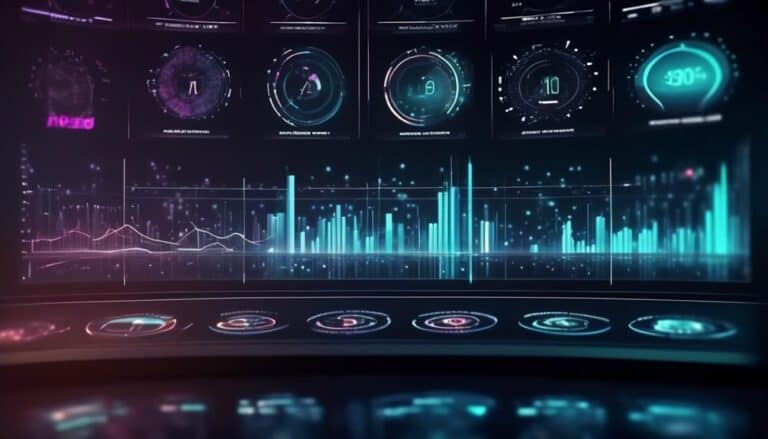Beyond the Analytics Dashboard: Deep Dive Into Ai-Powered Traffic Analysis
When it comes to analyzing traffic patterns, the analytics dashboard is like a surface-level map, providing a bird's eye view of your data landscape.
However, have you ever wondered what lies beneath the traffic patterns you see? The realm of AI-powered traffic analysis delves into a world where hidden insights and predictive capabilities await, offering a deeper understanding of the traffic ecosystem.
Explore how AI uncovers intricate patterns, predicts future traffic flows, and revolutionizes traditional traffic analysis techniques.
The possibilities that AI brings to traffic management and insights are vast, promising a future where innovation and efficiency intersect seamlessly.
Key Takeaways
- AI-Powered Traffic Analysis Techniques focus on core algorithms for real-time data processing and optimizing traffic flow and efficiency.
- Advanced Traffic Pattern Detection involves AI analyzing real-time data streams precisely to detect hidden patterns and predict future traffic trends.
- AI in Traffic Flow Prediction utilizes real-time data analysis, historical data, and machine learning algorithms for accurate trend identification and continuous learning.
- AI for Traffic Management Enhancement provides real-time traffic monitoring insights, predictive analysis for forecasting traffic flows, dynamic traffic signal optimization, and optimized route planning for efficient traffic management.
Understanding AI-Powered Traffic Analysis

To comprehend the intricacies of AI-powered traffic analysis, delve into the core algorithms driving real-time data processing and pattern recognition. AI accuracy is paramount in optimizing traffic flow and efficiency. By leveraging advanced machine learning models, AI can predict traffic patterns with precision, allowing for proactive adjustments to optimize traffic flow. The key to enhancing traffic optimization lies in the ability of AI systems to continuously learn from real-time data streams, adapting to changing conditions on the fly.
AI accuracy isn't a static concept but a dynamic process that evolves as more data is processed and patterns are identified. Through sophisticated algorithms, AI can analyze vast amounts of data in milliseconds, making split-second decisions to improve traffic conditions. This iterative approach to data analysis enables AI-powered systems to fine-tune their performance continually, leading to enhanced traffic optimization strategies.
Uncovering Hidden Traffic Patterns
AI-powered traffic analysis systems have the ability to uncover hidden traffic patterns by analyzing real-time data streams with precision and adapting to changing conditions on the fly. This capability allows for a deeper understanding of traffic behavior and enables anomaly detection in a proactive manner.
Through the utilization of advanced algorithms, these systems excel at detecting hidden patterns that may not be apparent through traditional analysis methods. By employing predictive modeling techniques, AI can anticipate future traffic trends based on historical data and current observations, offering valuable insights for optimizing traffic flow and resource allocation.
Here are some key aspects to consider when uncovering hidden traffic patterns:
- Utilizing machine learning algorithms for real-time pattern recognition
- Leveraging historical data to identify recurring traffic anomalies
- Implementing dynamic models that adjust to evolving traffic conditions
- Integrating predictive analytics to forecast traffic patterns and optimize decision-making.
Predicting Traffic Flows With AI

Predicting traffic flows using advanced AI algorithms involves analyzing real-time data to anticipate future patterns and optimize decision-making. Traffic forecasting, a critical aspect of transportation management, leverages machine learning algorithms to predict traffic conditions and plan accordingly. By utilizing historical data, real-time traffic updates, and external factors such as weather and events, AI models can forecast traffic patterns with impressive accuracy.
Machine learning algorithms, such as neural networks and decision trees, process vast amounts of data to identify trends and patterns that humans might overlook. These algorithms continuously learn and adapt from new information, improving their predictive capabilities over time. Through the analysis of these patterns, transportation authorities can make informed decisions to optimize traffic flow, reduce congestion, and enhance overall efficiency.
Leveraging AI for Traffic Management
In optimizing traffic management, AI serves as a powerful tool for analyzing and enhancing transportation efficiency. By leveraging AI for traffic control, you can revolutionize the way traffic is managed and make significant improvements in overall traffic flow.
Here are some key ways AI optimization can transform traffic management:
- Real-Time Traffic Monitoring: AI algorithms can process vast amounts of data from various sources such as cameras and sensors to provide real-time insights into traffic conditions.
- Predictive Traffic Analysis: By analyzing historical data and current traffic patterns, AI can predict future traffic flows and congestion hotspots, allowing for proactive traffic management strategies.
- Dynamic Traffic Signal Optimization: AI-powered systems can adjust traffic signal timings in real-time based on the current traffic volume, reducing congestion and improving traffic flow.
- Optimized Route Planning: AI algorithms can suggest the most efficient routes for drivers based on real-time traffic data, helping to reduce travel times and alleviate traffic congestion.
Enhancing Traffic Insights With AI

Building upon the foundations of optimizing traffic management through AI, the focus now shifts towards enhancing traffic insights with advanced analytical tools. AI integration in traffic analysis has revolutionized the way data is processed and interpreted. By harnessing the power of artificial intelligence, traffic optimization strategies can be fine-tuned with unprecedented precision and efficiency. Through the utilization of AI-powered algorithms, real-time traffic data can be analyzed to identify patterns, predict congestion hotspots, and optimize traffic flow.
AI integration enables the extraction of valuable insights from vast amounts of traffic data, allowing for proactive decision-making and adaptive traffic management strategies. By leveraging machine learning and predictive analytics, traffic insights can be enhanced to anticipate future traffic conditions, optimize signal timings, and improve overall transportation efficiency. These advanced analytical tools not only streamline traffic operations but also pave the way for smarter, more responsive urban planning initiatives. Embracing AI in traffic analysis opens up a realm of possibilities for creating dynamic, data-driven solutions that revolutionize the way we approach traffic management.
Revolutionizing Traffic Analysis Techniques
You can now explore how AI is transforming traffic analysis techniques by unlocking enhanced data insights, enabling real-time traffic monitoring capabilities, and predicting future traffic patterns with unprecedented accuracy.
This revolution in traffic analysis techniques is reshaping the way traffic data is collected, analyzed, and utilized to optimize transportation systems and improve overall road safety and efficiency.
Enhanced Data Insights
With the advent of AI-powered technologies, the landscape of traffic analysis has been fundamentally transformed by the integration of Enhanced Data Insights, ushering in an era of unprecedented accuracy and efficiency. Leveraging advanced data visualization techniques and AI algorithms enables in-depth analysis of traffic patterns and trends.
Machine learning applications play a pivotal role in deciphering complex traffic behavior, allowing for real-time adjustments and predictions. Enhanced Data Insights empower organizations to make data-driven decisions swiftly, optimizing traffic flow and resource allocation.
The amalgamation of AI algorithms with Enhanced Data Insights not only revolutionizes traffic analysis techniques but also paves the way for a more dynamic and responsive traffic management system.
Real-Time Traffic Monitoring
Real-time traffic monitoring integrates cutting-edge AI technologies to revolutionize traditional traffic analysis methods, enhancing precision and responsiveness in managing traffic flow.
By leveraging real-time data processing, this advanced system enables traffic optimization through instantaneous adjustments based on current conditions. Through the utilization of AI algorithms, patterns in traffic behavior can be swiftly identified, allowing for proactive decision-making and efficient resource allocation.
Real-time alerts play a crucial role in this process, providing immediate notifications of any anomalies or congestion points, enabling authorities to take swift action to mitigate potential disruptions. This dynamic approach to traffic monitoring not only enhances overall efficiency but also contributes to a safer and smoother traffic experience for all road users.
Predictive Traffic Patterns
Predictive traffic patterns are transforming the landscape of traffic analysis techniques by leveraging advanced AI algorithms to anticipate and adapt to traffic conditions proactively. This innovative approach combines traffic forecasting and machine learning to revolutionize how traffic data is utilized for optimization purposes.
Here are key aspects highlighting the impact of predictive traffic patterns:
- Data-Driven Predictions: Utilizing vast amounts of historical and real-time traffic data to generate accurate predictions.
- Traffic Optimization: Adjusting traffic flow in real-time based on predicted patterns to optimize efficiency.
- Machine Learning Algorithms: Constantly learning from new data to enhance prediction accuracy over time.
- Improved Decision-Making: Empowering traffic management authorities to make informed decisions to alleviate congestion effectively.
Future of Traffic Analysis: AI Innovations
AI-powered traffic analysis is poised to revolutionize the way transportation systems are monitored and managed in the near future. With the integration of AI into traffic analysis, the accuracy and efficiency of traffic forecasting are set to reach unprecedented levels. Advanced machine learning algorithms can process vast amounts of data in real-time, enabling traffic management systems to adapt dynamically to changing conditions.
One of the key innovations on the horizon is the use of AI to optimize traffic signal control. By analyzing traffic patterns and adjusting signal timings in response to current demand, AI systems can significantly reduce congestion and improve traffic flow. Moreover, AI-powered predictive analytics can anticipate traffic bottlenecks and proactively suggest alternative routes to minimize delays.
As AI continues to evolve, we can expect traffic analysis systems to become even more adept at handling complex urban traffic environments. By harnessing the power of AI, transportation authorities can make data-driven decisions that enhance mobility, reduce emissions, and improve the overall efficiency of transportation networks. The future of traffic analysis is bright, with AI innovations paving the way for smarter, more sustainable urban mobility solutions.
Frequently Asked Questions
Can Ai-Powered Traffic Analysis Be Used to Predict Accidents and Prevent Traffic Congestion in Real-Time?
Using AI-powered traffic analysis for accident prediction and real-time congestion prevention is crucial. By leveraging advanced algorithms, data patterns are detected swiftly, allowing proactive measures to be implemented, enhancing overall traffic safety and efficiency.
How Does AI Analyze Data From Multiple Sources to Provide More Accurate Traffic Predictions?
To provide more accurate traffic predictions, AI analyzes data from multiple sources through data integration. It examines traffic patterns, utilizing real-time information to adapt and enhance its forecasting capabilities, contributing to more precise insights for traffic management.
What Are the Potential Privacy Concerns Associated With Using AI for Traffic Analysis?
Privacy implications and ethical considerations arise when utilizing AI for traffic analysis. Personal data collection, potential surveillance, and the need for transparent data handling practices are key concerns. Balancing innovation with data protection is crucial.
How Can AI Be Leveraged to Optimize Traffic Signal Timings and Reduce WAIt Times at Intersections?
To optimize efficiency and reduce emissions at intersections, AI can analyze real-time traffic data to adjust signal timings. By leveraging AI, you can minimize wait times, improve traffic flow, and enhance overall transportation infrastructure effectiveness.
Are There Any Limitations to Ai-Powered Traffic Analysis in Terms of Handling Unexpected Events or Sudden Changes in Traffic Patterns?
In real-time scenarios, AI-powered traffic analysis may encounter adaptability challenges when handling unexpected events or sudden traffic pattern changes. Limitations in real-time monitoring can hinder quick adjustments, affecting overall system responsiveness.
Conclusion
In conclusion, AI-powered traffic analysis offers a deeper understanding of traffic patterns, predicts traffic flows, and enhances traffic management strategies.
By revolutionizing traditional traffic analysis techniques, AI is paving the way for innovative solutions to optimize traffic efficiency and reduce congestion.
The future of traffic analysis lies in the continued advancements of AI technology, providing new insights and capabilities to improve transportation systems worldwide.








